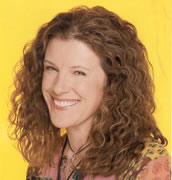

|
 Mimi
Kennedy Mimi
Kennedy
Mimi Kennedy,
co-star of TV's Dharma & Greg, is also known as an activist, environmentalist,
author, and philanthropist. Her many contributions to the community include
her active involvement with and support of the Spondylitis Association
of America (SAA) for many years. Having concluded five seasons (more
than 120 episodes) of the Golden Globe nominated television series, "Dharma
& Greg," Rochester, New York-born, Mimi Kennedy is one of the
rare actresses who can boast a list of credits including Broadway theatre
stage, primetime television drama, variety and comedy series, Oscar-winning
feature film and behind-the-scenes work as a director, story-editor and
voice-over artist. She also successfully managed to balance a full-time
performance career along with a second career as a respected author and
as a noted activist in political, human rights, environmental and animal
issues while maintaining a devoted, healthy marriage and family life raising
two teenagers in Los Angeles.
Mimi Kennedy's memoir of Catholic girlhood, coming-of-age as an actress,
wife, and mother, Taken
to the Stage: The Education of an Actress, garnered praise
for her literary debut. Kennedy is currently writing her second book,
a novel that covers the issue of water and the health of the planet and
also about the responsibility of the powerful to take positions of leadership.
|

Stop Ankylosing Spondylitis!
For years, Harry Bruckel was our tax preparer, and one of the best parts of
tax time for me and my husband was seeing the pictures of Harry and his wife
Jane on their previous year's vacation, just after tax time. Harry always described
the trip they would take when this year's returns were in.
We saw pictures of Africa, New Guinea, South America, and it was clear the
Bruckels were intrepid.
One year, Harry alluded to his wife's illness. They were still traveling, he
said, but they'd begun to plan with her limitations in mind. He told us of their
plans to start an organization to help people with Jane's condition, because
so little was known about it, and they wanted everyone to help each other find
out more, and support each other. He sent us an envelope, when he sent us our
returns to sign and submit. The envelope had those imposing words "Ankylosing
Spondylitis". That was the first time I saw them, and the first time I contributed
to the cause.
Ankylosing Spondylitis (AS) is basically arthritis of the spine. "Anklos" means
bent, or bowed. "Spondy" means vertebrae. The bones of the spine fuse, slowly,
as the disease progresses. Hips and shoulders can be affected, as well as eyes,
heart and lungs. To the casual observer, someone with AS might look only like
someone with an extremely stiff neck, or back pain, or a recent hip or leg injury.
Without being aware that AS exists, people can't even guess that when they see
someone who is moving slowly, or struggling with a physical task that seems
simple, or cannot turn easily when addressed, might be someone with AS - not
an injury, or an attitude, but a chronic, degenerative condition robbing bodies
of flexibility and motility. There are more people with AS than cystic fibrosis,
Lou Gehrig's disease, and multiple sclerosis combined.
I have a childhood best friend suffering from MS. My cousin lost her husband
to Lou Gehrig's disease. There is no such thing as competitive diseases, in
my mind. I believe that every diagnosed condition will have, and deserves, supporters
to lessen the impact of the condition on those affected. To suffer the loss
of any aspect of physical health is bad enough; to suffer that in ignorance
- one's own, or others' -is isolating and, in our age of communication, unnecessary.
AS is not the arthritis associated with aging. AS strikes the young. The typical
age of onset is between 17 and 35. It is the most frequently overlooked cause
of persistent back pain in young people.
Awareness of AS will help doctors and patients diagnose the disease earlier.
Although there is no cure yet, proper medical management can minimize pain and
stiffness and help reduce the risk of disability and deformity, which is enormously
important for young people facing an AS diagnosis. Awareness of AS will also
generate funds for a cure, and continued development of drugs to mitigate the
impact of the disease. Jane Bruckel reports that a new drug she's being given
makes her feel "better than I have in thirty years." There is some hope that
the new drugs, as they lessen pain and maximize flexibility, might slow the
disease's development in significant ways.
Awareness of AS will help everyone respond in helpful ways. Small adjustments
such as facing someone directly who cannot turn to you when talking side-by-side,
or from behind, can make things much easier for people with AS, but people won't
think to make those adjustments if they are not aware of the subtle physical
traits that indicate the presence of AS in someone who is otherwise not visibly
disabled in anyway.
There is hope for a cure, with the progress of genetic research. The cause
of AS, is a mystery shared with MS, ALS (Lou Gehrig's) and so many other degenerative
conditions that strike twenty-first century humans. We must be made aware of
who suffers, and what they suffer. I'm proud to lend my energy to the cause
of finding a cure for, spreading awareness about, and relieving the suffering
of the little-know disease with the big name: Ankylosing Spondylitis.
For more information on ankylosing spondylitis, click
here.
For more information about Mimi Kennedy, click
here.

Created: 6/29/2002 - Mimi Kennedy



